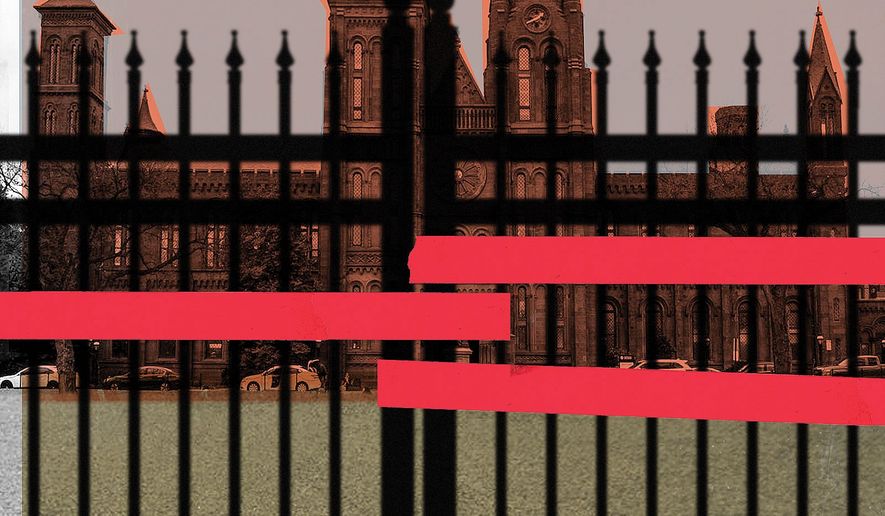OPINION:
The closure of the Smithsonian Institution museums during the government shutdown is an inconvenience both for tourists as well as those of us in the Washington area with young children who enjoy visiting the museums.
However, this vulnerability to the vicissitudes of federal budget impasses is just one of a litany of problems with the city’s museums. Besides being vulnerable to increasingly common government shutdowns, the museums are overcrowded, run down and out of date, facts that the incredible new African-American museum — which has none of these problems — has made abundantly clear.
Fortunately, there is a simple solution to all of these problems: Implementing an admittance fee to the Smithsonian museums for non-city residents.
Nothing has exemplified the problems with the status quo as abundantly as the degradation of the National Air and Space Museum on the National Mall over the last few years. Those of us who have been regular visitors are painfully aware of the fact that it has been an uninspired, shambolic mess for some time, with dated exhibits, a hands-on section — always the most popular part for young children — bereft of maintenance, and video presentations that are almost comically old. Until recently the museum featured a short video on weather satellites narrated by a young Willard Scott.
The obsolescence of the Air and Space Museum was in part intentional, done in anticipation of (and, I suspect, as a strategy to hasten) funds from Congress to remodel and renovate the building. It worked, and the renovation is about to commence, with a good portion of the museum to be closed for the next seven years until renovations conclude — an insanely long time to accomplish such a task.
However, there is really no incentive for museum management to hasten things: Taking a slow and methodical approach toward updating the museum makes sense given that they have been given a fixed budget that it must stretch any way it can, and it loses absolutely no revenue by taking so long. However, if the renovation were to result in them losing hundreds of thousands of dollars in revenue each day they were out, administrators might start thinking creatively about speeding up the process — and have the wherewithal to act.
The Air and Space Museum isn’t the only museum in need of renewal: The National Museum of Natural History feels in dire need of some sort of updating, and the National Museum of American History could use a few new things as well. And the National Museum of the American Indian needs a complete do-over.
The opening of the National Museum of African American History and Culture, which may be the most compelling museum in the entire country at present, has made the other museums’ flaws abundantly clear. It is a museum that tells a story in a way that every visitor finds accessible. Everything about the museum, from its addictive and educational interactive displays to its rare videos to its fascinating historical items — including Chuck Berry’s Cadillac — draw in the visitor. Even the guards are friendly and engaged. It shows us what a museum can be in 2019, which is something entirely different than in 1999, where most of our other museums seem to be stuck.
In addition, the Smithsonian requires tickets to enter the museum and it has strictly limited these tickets, which means that there are no long lines and the rooms are blissfully uncrowded — in notable contrast to the other museums.
To bring the other museums up to something approaching the level of the African American history museum will take two things: More money and a similar constraining of visitors. The way to achieve both is simple: Begin charging a fee to attend our museums.
The fee need not be exorbitant: $20 per visitor to one museum per day ought to be sufficient, with a discount for people visiting multiple museums in multiple days. And perhaps we could provide a discount — or even free tickets — to residents of Washington, D.C., but still insist that they procure tickets in advance with everyone else.
The argument against this is invariably “what about the poor?” But there is no reason to use this trope as a reason to subsidize everyone else, the vast majority of whom can easily afford to shell out a few dollars during a visit to the Smithsonian. For a family traveling hundreds of miles and spending multiple nights in a hotel, a museum fee represents a trifle.
The sad fact is that the Smithsonian museums are not the jewels we make them out to be, and that many of the museums found in Chicago, New York, Boston, and elsewhere across the country put them to shame. It is time to make real investments into the Smithsonian, and the way to do so is to make it less dependent on Congress for its money — as well as its operating status.
• Ike Brannon is a senior fellow with the Jack Kemp Foundation




Please read our comment policy before commenting.